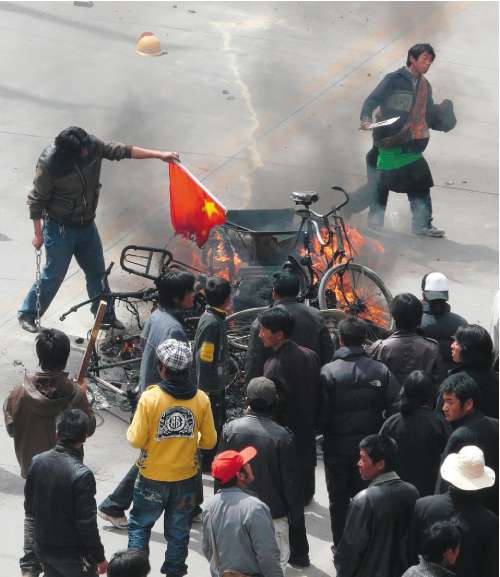Four die and dozens more injured as Tibet protests descend into violence

China is facing the biggest challenge to its rule over Tibet in two decades after clashes between angry demonstrators and police in Lhasa left four people dead and dozens more injured. Hundreds of protesters shouting "Free Tibet" yesterday took the place of Buddhist monks who had been marching peacefully over the past two days.
The demonstrators set fire to shops and cars and police opened fire on the crowds prompting a warning by the Dalai Lama to the Beijing government to stop using "brute force". One witness in Lhasa said: "The situation is very tense. Everyone is very afraid." Major monasteries in the city were surrounded by soldiers and police last night.
One Han Chinese woman, who was in Lhasa on business, said that she had seen tanks on the street, but she could not say much more as the police were everywhere in her hotel.
"It was chaos everywhere. I could see fires, smoke, cars and motorcycles burning," said a Tibetan guide who spoke on condition his name not be used, fearing retaliation by authorities. The guide said armed police in riot gear backed by armoured vehicles were blocking major intersections in the city, along with the broad square in front of the Potala, the former winter home of Tibet's exiled Buddhist leader, the Dalai Lama.
Early yesterday morning, in the Barkhor area of Lhasa, hundreds of Tibetans joined a demonstration led by four university students. More than 1,000 police were deployed, using tear gas. Clashes left four police injured, said the Free Tibet Campaign.
The United States embassy in Beijing says Americans in Lhasa have also reported gunfire and rioting.
Demonstrations took place in front of the Potala Palace, the iconic edifice that was once the Dalai Lama's winter residence and is the symbol of Lhasa's strength as well as its isolation. While Lhasa is a place of pilgrimage for Tibetans, it is also a popular tourist destination with Han Chinese and this conflict is one of the reasons for this week's demonstrations.
The protests are the biggest since the late 1980s, when riots led to martial law being imposed – and China's current President, Hu Jintao, was the Communist Party chief in Tibet.
These acts of defiance in Tibet come just five months before the Olympic Games in Beijing, when the eyes of the world will be on China. Tibetan activists are expected to use the extra attention to highlight their cause. The situation leaves President Hu with some tough decisions to make. If he does not react, he risks the spread of instability and opposition in Tibet. If he reacts too violently, he is in will earn international anger in an Olympic year.
Some of the biggest demonstrations took place in the remote monastery town of Xiahe in China's Gansu province, in the mainly Tibetan Amdo region. Three million Tibetans live in Chinese territory outside Tibet. Hundreds of monks marched to the local government offices, some flying Tibetan national flags and police opened. The monastery was sealed off and truckloads of police were being brought in.
Washington, the EU and the Dalai Lama all urged the Chinese government to respond in a restrained manner. "These protests are a manifestation of the deep-rooted resentment of the Tibetan people under the present governance," the Dalai Lama said. "I appeal to the Chinese leadership to stop using force and address the long-simmering resentment of the Tibetan people through dialogue."
The week began with peaceful street protests as monks marked the 49th anniversary of the failed uprising against Chinese rule that culminated in the Dalai Lama's exile.
In the past few days there have been violent clashes as frustrated Tibetans protest against colonisation by Han Chinese. The Chinese claim they are trying to bring Tibet into the 21st century and want to help support the region economically.
In the midst of all the chaos, the message from the demonstrators was clear. "I have a message for Tibetans abroad: don't stop supporting us. If you stop, it makes the risks we're taking useless," said one protester.
Dr Dibyesh Anand: Resentment towards Chinese migrants has boiled over
There is a new dimension to these protests: open resentment of ethnic Tibetans against Chinese migrants. This will test the policy of encouraging non-Tibetan migration. It could also create greater problems in the future where retaliation against ethnic Tibetans might surface in the rest of China.
Tibetans have been a core part of Chinese nationalism throughout the 20th century. So even the hypothetical end of Communist Party dominance will not lead to independence. The Dalai Lama gave up this demand many years ago. China, rather than blaming him, should understand that he is its greatest ally. He has the ability to assure most Tibetans that their fate lies with China.
The writer is the author of Geopolitical Exotica: Tibet in Western Imagination
Join our commenting forum
Join thought-provoking conversations, follow other Independent readers and see their replies
Comments